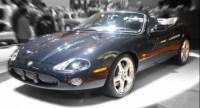|
Lexus IS200 Sportcross
Long Term Road Test & Review
Having parted company with our long term Celica test car it was time to select a replacement. We'd loved the Celica for its outstanding reliability, great build quality and fine handling, so a direct replacement by another Celica was a very real consideration. However, whilst the Celica's hatchback more than matched the capacity of other cars in its class, we needed something with considerably more carrying capacity.
Another sports coupe or a hatchback wasn't going to be big enough, and a saloon wasn't going to cover our requirements. But on the other hand we didn't want a full sized estate car
either, so we took a look at the Lexus IS200 Sportcross - a sports
tourer with the benefit of a large tailgate and reasonably good load
space, without the extra bulk and weight of a full size estate car.

Lexus IS200 Sportcross
The little Lexus is the result of an immense
amount of work by Lexus and sister company Toyota to produce a
car that would compete against mainstream executive cars such as
the BMW 3 Series and Audi A4. No doubt Toyota had realised
that many potential owners of their larger cars were driving the
smaller BMWs, Mercedes, Jaguars and Audis before stepping up the
larger executive models. Toyota needed a compact executive
car of their own to bring these drivers over to the Lexus brand.
Before acquiring its Lexus badge the IS200 was
first marketed in Japan as the Altezza where it was fitted with
straight 4 engine. Lexus marketing was thorough enough to
realise that although the rear wheel drive chassis was perfect
for the new baby Lexus, straight 6 two and three litre engines
would be better suited to the European luxury car market.
Unfortunately, for some bizarre reason they elected to offer the
3 litre engine only with a standard automatic gearbox in the
shape of the IS300.
The smaller IS200s are available with either
manual transmission as standard, or an optional automatic
gearbox. We'd rather fancied the 3 litre model, but
couldn't face the prospect of the automatic gearbox so we
elected for a 2 litre manual version for our test.
On the Road
First impressions of the 200 on the road are
that the performance and handling is nearly identical to the
saloon version of the IS200. A key design criteria was
that the Sportcross should weigh no more than the saloon, so a
lightweight aluminium tailgate was produced to prevent the
tailgate adding any extra weight to the car. This single
decision makes a huge difference to the value of this vehicle -
the extra weight of a steel tailgate would have killed its
handling - resulting in a car that had an inferior driving
experience. And a secondary benefit of the light tailgate
is that it's a delight to operate - something you appreciate
every time you load up the car.
The performance of the 2 litre engine is
superb - Toyota VVTi technology ensures that much of the
engine's 153bhp is available across the rev band - so you rarely
feel as if you need more power on the road. And the slick,
six speed gearbox ensures that you can get the most out of the
engine, though 6th really is a cruising gear on this car with
just over 3000 revs on the counter at 70mph when in top
gear. This is very different to the six close ratio gears
on the Celica which were required to keep it in its rev band.
Although they hail from the same design studios, the Celica and
the IS200 are so very different in almost every respect.
Ride quality of the vehicle is very
good. The suspension is a little higher - and perhaps a
little harder than the Saloon models, but the Sportcross doesn't
get the 17" wheels and associated low profile tyres fitted
to the IS200 Sport saloons, so the ride is still very
smooth. As a result, the car can make rapid, comfortable
progress without too much fuss or noise.
When pushed harder, the noise in the cabin
increases - almost as if Lexus have tuned the vehicle's exhaust
to be quiet when cruising, but to make a sporty note when
pushed.
At the limits of handling the car's rear wheel
drive chassis is evident and it's a joy to drive. The
standard traction control doesn't take over too quickly to spoil
the fun either.
Ownership Experience
Needless to say, we were so taken with the
IS200 that it's now our regular transport. And living with
it only increases your admiration for its abilities. The
blend of materials used to create the interior is superb.
The controls are perfectly placed, and the electrically adjusted
seats glide smoothly in all directions to ensure that every
driver can find a comfortable position.
In terms of practicality the car has all the
storage space we need, and some clever tricks like the folding
boot floor which can be lowered for higher volume, or raised to
provide a flat floor. In the latter position, a handy
'secret' space is provided under the boot floor, which is ideal
for hiding valuables out of sight. It would be even better
if the floor were lockable though.
We also love the front passenger seat which
can be folded flat so that its back forms a table that the
driver can use when the car is stationery. For anyone who
needs to work from their car this is ideal. It's also very
handy if you need to carry unusually long items in the vehicle.
Faults
This particular IS was 18 months old when we
acquired it, and we've now had it just over a year with very
little to complain about. In common with many Japanese
cars we're seeing some corrosion of the alloy wheels despite the
fact that the have been well looked after and have never been
kerbed. This will be rectified under warranty.
We've also had a blown bulb in one of the
reading lights - the centre console one located next to the
sun-roof controls. This isn't a problem as Lexus
generously provide a separate large interior light to the rear
of the sun-roof, and also lights inside each of the
sun-visors. However, it's infuriating that the owners'
manual doesn't cover the changing of this bulb, and we can't
figure out how to do it. It will have to be picked up in
the next service.
Finally, a minor quibble about the car's
performance in deep snow. We all love rear wheel drive
cars when conditions are fine, but when you're struggling up a
steep hill in winter, front wheel drive would certainly be
better. The IS200 is actually fitted with a Snow button,
which is presumably meant to alter the traction control to
improve its behaviour in such conditions. In our
experience the button doesn't do very much. But we're
prepared to forgive that because for the other 364 days of the
year the handling was awesome for such a practical vehicle.
|










